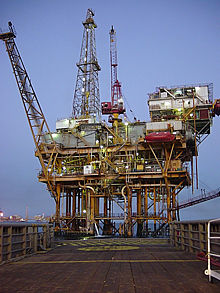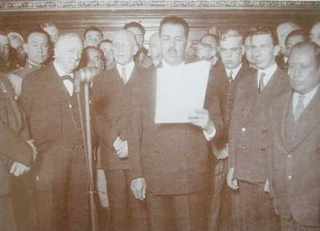- Petroleum industry in Mexico
-
The petroleum industry in Mexico makes it the sixth largest producer of oil in the world and the tenth largest in terms of net export as of 2007. It is the second largest oil producer in the Western Hemisphere behind only the United States and just ahead of Canada. However, Mexico is not a member of OPEC or any petroleum production related organizations.
The oil sector is crucial to the Mexican economy; while its importance has been reduced in recent years, oil revenues generate over 10% of Mexico's export earnings.[1]
Contents
History
Exploratory wells were first drilled in Mexico in 1869, but oil was not discovered until the turn of the twentieth century. By 1901, commercial production of crude oil in Mexico had begun. By 1910, prospectors had identified the Panuco-Ebano and Faja de Oro fields located near the central Gulf of Mexico coast town of Tuxpán. Systematic explorations by foreign companies (mainly American) came to supersede the uncoordinated efforts of speculative prospectors. Mexico became an oil exporting nation in 1911.[citation needed]
Legally, Article 27 of the constitution of 1917 granted the Mexican government the permanent and complete rights to all subsoil resources. This would cause conflicts between the Mexican government and foreign companies - especially American oil companies - until the matter was resolved in the 1930s. In 1925, President Plutarco Elías Calles decreed that foreign oil companies must register their titles and limited their concessions to fifty years.[citation needed]
During the 1920s, Mexico was second behind the United States in petroleum output and led the world in oil exports. However, as a consequence of worldwide economic depression, the lack of new oil discoveries, increased taxation, political instability, and Venezuela's emergence as a more attractive source of petroleum, output during the early 1930s had fallen to just 20% of its 1921 level.[2] Production began to recover with the 1932 discovery of the Poza Rica field near Veracruz, which would become Mexico's main source of petroleum for the next several decades.
Oil expropriation
Main article: Expropiación petroleraIn 1935, all companies in the business of oil production in Mexico were foreign companies. Labor practices in these companies poorly benefited the workers since the companies were able to block the creation of labor unions through legal and illegal tactics. Despite legal opposition, the Confederation of Mexican Workers was created and proposed a project of general contracts for each oil company. A strike was planned to push towards an agreement but the matter went to the court instead. On December 18, the Arbitration Board declared in favor of the union and ordered the oil companies had to pay 26 million pesos in lost wages because of the strike.
Mexican President Lázaro Cárdenas intervened in the legal preceding by expropriating the oil industry and nationalized the petroleum industry, giving the Mexican government a monopoly in the exploration, production, refining, and distribution of oil and natural gas, and in the manufacture and sale of basic petrochemicals. Between 1938 and 1971, Mexico's oil output expanded at an average annual rate of 6%.[3] In 1957, Mexico became a petroleum net importer after domestic demands exceeded domestic production. However, production rose to 177 million barrels (28.1×106 m3) by 1971 with the exploitation of new oil fields in the isthmus of Tehuantepec and natural gas reserves near the northeastern border city of Reynosa, but the gap between domestic demand and production continued to widen.
Post-nationalization
1973 witnessed Mexican oil production surpassing the peak of 190 million barrels (30×106 m3) achieved in the early 1920s. In 1974 Pemex announced petroleum discoveries in Veracruz, Baja California, Chiapas, and Tabasco. In 1976, President López Portillo announced that Mexico's proven hydrocarbon reserves had risen up to 11 billion barrels (1.7×109 m3). By 1983, that figure further rose to 72.5 billion barrels (11.53×109 m3). Portillo then decided to increase Mexican petroleum production and use the value of the reserves as collateral for acquiring large international loans, most of which went to Pemex. From 1977 to 1980, Pemex received $12.6 billion in international credit, representing 37% of Mexico's total foreign debt but nevertheless used the money to construct and operate offshore drilling platforms. Pemex further expanded by building onshore processing facilities, enlarging its refineries, and vastly improving its production capabilities. These investments led to an increase in petroleum output from 400 million barrels (64×106 m3) in 1977 to 1.1 billion barrels (170×106 m3) by 1982. By 2007, Mexico had a net oil export of 1.756 million barrels per day (279.2×103 m3/d).[4]
Oil production
Mexico produces three grades of crude oil: heavy Maya-22 (accounting for more than half of the total production); light, low-sulfur Isthmus-34 (28% of production); and extra-light Olmeca-39 (20% of production). At the beginning of 2002 Mexico had the second largest proven oil reserves in the Western Hemisphere with 30.8 billion barrels (4.90×109 m3). However, according to Pemex, Mexico’s reserves/production ratio fell from 20 years in 2002 to 10 years in 2006, and Mexico had only 12.4 billion barrels (1.97×109 m3) of proven oil reserves left by 2007.[5] Mexico stands ninth in the worldwide ranking of conventional oil reserves with only Venezuela higher in the Western Hemisphere (although Canada ranks higher if proven reserves of unconventional oil in oil sands are included).
Pemex is Mexico's state-owned petroleum company and the sole supplier of all commercial gasoline (petrol/diesel) stations in the country. Cantarell Field is the largest oil field in Mexico and one of the largest in the world producing. As of 2007, Mexico has approximately 12.4 billion barrels (1.97×109 m3) in proven oil reserves. In November 2006, Pemex reported that Cantarell has produced 11.492 billion barrels (1.8271×109 m3) of oil.[6] Several oil fields have also been discovered in the Chicontepec Basin. The Chicontepec fields contains Mexico's largest, certified hydrocarbon reserve, totaling more than 19,000,000,000 barrels of oil equivalent (1.2×1011 GJ) with original oil in place of over 139,000,000,000 barrels of oil equivalent (8.5×1011 GJ); recovery is complicated by challenging, low recovery rate reservoirs, but is made more attractive due to the presence of light and super-light oil.[7]
In 2002, the Ku-Maloob-Zaap oil field was discovered offshore in the Bay of Campeche, 105 kilometers from Ciudad del Carmen. Pemex plans to drill 82 fields and install 17 oil platforms, as well as build an oil pipeline of 166 kilometers to transport the oil produced. By 2011, production is expected to reach 800 thousand barrels per day (130×103 m3/d) and 282 million cubic feet (8.0×106 m3) of natural gas.
In an interview on the oil news website, oilcast.com, in November 2005, an anonymous Pemex employee revealed the company's inability to increase production, stating that the country is at Hubbert's Peak.[8] The individual interviewed believed export levels could not be recovered once peak had passed, as the size of current fields that have been discovered or are coming online represent a fraction of the size of the oil fields going into terminal decline.
 Offshore platform in the Gulf of Mexico
Offshore platform in the Gulf of Mexico
Annual production has dropped or failed to increase each year since 2004.[9] Furthermore, it has been reported the 2005-2006 daily oil production was down by approximately 500 thousand barrels per day (79×103 m3/d) on the previous year. Nevertheless, Mexico still produced approximately 3.42 million barrels (544×103 m3) of oil per day ranking it sixth in the world in terms of total production.[10] In the first quarter of 2009, Mexican oil production was down to 2.667 million barrels (424,000 m3) per day, down 7.8 percent from a year earlier. [11]
Year Oil Production Rank Percentile Change million barrels per day thousand cubic meters per day 2003 3.59 571 5 N/A 2004 3.59 571 5 0.00% 2005 3.46 550 5 -3.62% 2006 3.42 544 6 -1.16% 2007 3.42 544 6 0.00% See also
- Chart of exports and production of oil by nation
- Economy of Mexico
- Energy in Mexico
- Electricity sector in Mexico
- List of oil-producing states
Notes and references
- ^ Mexico Energy Data, Statistics and Analysis - Oil, Gas, Electricity, Coal
- ^ Mexico Oil
- ^ "Mexico Oil". http://www.country-studies.com/mexico/oil.html.
- ^ EIA - International Energy Outlook 2007 - Petroleum and Other Liquid Fuels Section
- ^ "Mexico - Oil". Country Analysis Briefs. U.S. Energy Information Administration. December 2007. http://www.eia.doe.gov/emeu/cabs/Mexico/Oil.html. Retrieved 2008-08-01.
- ^ "Pemex:". http://www.pemex.com/index.cfm?action=content§ionID=8&catID=40&subcatID=3672.
- ^ "Mexico's northern region launches massive development". World Oil. 2001. http://findarticles.com/p/articles/mi_m3159/is_11_222/ai_80326155.
- ^ http://www.oilcast.com www.oilcast.com
- ^ http://www.eia.doe.gov/emeu/ipsr/t22.xls
- ^ Mexico Oil - production - Economy
- ^ "UPDATE 1-Mexico oil output falls 7.8 pct in Q1". Reuters. April 21, 2009. http://in.reuters.com/article/oilRpt/idINN2148560120090421.
External links
- Mexico's crude oil production chart (1980-2004) - Data sourced from the US Department of Energy
- Energy Secretariat (SENER)
- Energy Regulatory Commission (CRE)
- Energy Savings National Commission (CONAE)
 Mexico topics
Mexico topicsHistory Pre-Columbian civilizations · Colonization · War of Independence · First Mexican Empire · Mexico-USA War · La Reforma · French intervention · Second Mexican Empire · Porfiriato · Mexican Revolution · Wettest-known tropical cyclonesGeography Governance Federal government · Constitution · President · Congress of the Union · Supreme Court · Political divisions · Foreign relations · Law enforcementPolitics Economy Economic history · Peso · Bank of Mexico · Stock Market · North American Free Trade Agreement · Poverty · List of companies · Communications · Transportation · Tourism · Petroleum · Automotive market · Science and technology · Water supply and sanitationSociety Culture Other topics Petroleum industry in North America Sovereign states - Antigua and Barbuda
- Bahamas
- Barbados
- Belize
- Canada
- Costa Rica
- Cuba
- Dominica
- Dominican Republic
- El Salvador
- Grenada
- Guatemala
- Haiti
- Honduras
- Jamaica
- Mexico
- Nicaragua
- Panama
- Saint Kitts and Nevis
- Saint Lucia
- Saint Vincent and the Grenadines
- Trinidad and Tobago
- United States
Dependencies and
other territories- Anguilla
- Aruba
- Bermuda
- Bonaire
- British Virgin Islands
- Cayman Islands
- Curaçao
- Greenland
- Guadeloupe
- Martinique
- Montserrat
- Puerto Rico
- Saint Barthélemy
- Saint Martin
- Saint Pierre and Miquelon
- Saba
- Sint Eustatius
- Sint Maarten
- Turks and Caicos Islands
- United States Virgin Islands
Categories:- Energy in Mexico
- Petroleum industry by country
- Infrastructure in Mexico
- Oil industry in Mexico
Wikimedia Foundation. 2010.



